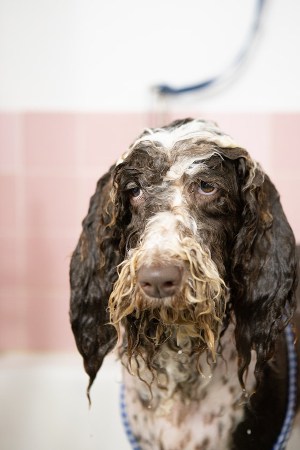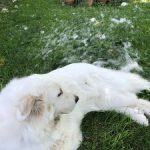
Are you almost tearing your hair out because your dog just won’t stop scratching?
Or is that you are tired of trying to sort out the tangles and matts in your dog’s coat?
Are you thinking that perhaps if you use human conditioner, all of your troubles will end and that your dog will have a coat of hair worthy of a supermodel?
If this is you, I would encourage you not to use human conditioner on your dog for the reasons that I will outline in this article.
And first up, I want to discuss why your dog’s hair might need to be conditioned in the first place.
Why does dog hair need conditioning?
On the surface, it looks like conditioner is used solely to soften hair and make it shinier. In reality, conditioner works deeper than that. Just like human shampoo, dog shampoo potentially strips too much of the hair natural oil, leaving it overly dry. Conditioner, true to its name, helps recondition the dog’s fur by retaining moisture.
For dogs especially, because they have hair all over their body, not only is conditioner good for the fur, but it also nourishes the skin. Furthermore, conditioner helps the shedding process by allowing the shed fur to fall off more easily, preventing knots.
However, it’s worth mentioning that in general dog shampoo alone should be sufficient for dog grooming, especially if the dog shampoo is already mild and non-irritant. But there are certain breeds and conditions that require a dog to use conditioner.
What is the difference between shampoo and conditioner?
The main purpose of shampoo is to cleanse the hair from dirt. Because of this, shampoos usually don’t contain many nutrients in them. Conditioner, on the other hand, works by softening hair cuticle, closing it up so the hair shaft can trap more moisture inside.
So, while shampoo works by cleaning the hair from the outside, conditioner works by retaining moisture from the inside. Conditioners also pack more nutrients in it compared to most shampoo.
What type of dog is most in need of conditioning?
- Dogs with Dry or Dull Coat
Conditioner’s main function is to keep dog’s coat and skin moisturized. Therefore, if you see that your dog’s coat is starting to look dry or dull, you can use conditioner so their hair can better trap natural moisture.
Dog fur tends to be drier in winter. If your dog generally has healthy skin and coat but they get dry in colder weather, you can give them conditioner only in winter.
- Dogs with Long Coats
Longer hair has a higher possibility of getting tangled. A lot of tugging to detangle your dog’s hair will result in discomfort or even pain for your beloved dog. The use of conditioner helps in detangling hair quicker and making the process less painful. It also helps the fur maintain softness even after it’s dry, making brush time easier.
- Dogs Who Bathe a Lot
As stated above, in order to really cleanse the fur, dog shampoo is overly stripping. This means that not only dirt gets washed off but also some of the coat’s natural oils. Not having greasy coat might seem like a good idea, but frequent shampooing tend to make the coat too dry.
If you bathe your dog more than once a month, it would be wise to re-moisturize their coat with conditioner after shampooing them. This will help close the hair shaft so it can trap more moisture. If your pup’s coat still looks dry and dull even after you use conditioner, try reducing their amount of bath time.
- Dogs with Itchy Skin
If your dog has rashes or itchy skin, conditioner can help soothe the itchy area. Conditioning your dog helps restore natural oil, thus easing itchy skin.
How is dog skin different to human skin?
Dogs and humans have different skin pH levels. Dogs’ skin has an average pH of 7, which means that it’s neutral. On the other hand, human scalp and hair pH is on the acid side of the spectrum, ranging from 4.8 to 6.0. This means that to maintain pH balance, dog conditioner needs to have a more neutral pH, while human conditioner is usually more acidic.
Aside from the pH itself, another difference is that because dogs don’t have the acidic mantle that human skin has, their skin is thinner. The acidic mantle on humans takes on the job of protecting the skin from bacteria or fungi growth, but dogs don’t have this. Therefore, it’s better to give your pup gentle conditioner that’s specially formulated with the thought of maintaining their skin barrier.
What is the difference between human conditioner and dog hair conditioner?
Human conditioner pH is usually in the acidic range while dog conditioner has neutral pH. Human scalp has an acid mantle that is washed away every time we shampoo, so human conditioner is formulated to restore the slightly acidic balance of human skin. If you use it on your dog, human conditioner will also try to bring the pH balance of the dog’s skin down to slightly acidic levels, which is not how the pH balance of dog skin should be.
Using human conditioner on dogs poses a risk of pH imbalance. This will in turn cause your dog to be more exposed to harmful pollutants.
Dog conditioners are also gentler. This is because dog conditioner is formulated not only for the hair but also for the skin. Human conditioner, particularly the cheap ones, contain a lot of sulphates like the infamous SLS. This kind of ingredient can be too irritating for dog skin.
Even if you’ve tried slathering your dog with human conditioner and you don’t see any side effects, it’s still best to use dog conditioner. Side effects may not come out right away so even if you don’t see any problem now, there might be some later. Overall, it’s just less risky to use human conditioner on humans and dog conditioner on dogs.
How often should conditioner be used on a dog?
If you have decided to use conditioner on your dog because of one of the conditions mentioned before, the conditioning frequency should follow the bathing frequency. Use the conditioner on your dog after you’re done shampooing them.
The regular bathing frequency for a dog is once every 1-3 months, depending on their coat length and skin condition. Other than that, simply bathe them only when they’re really dirty.and smelly. If the weather is really hot and humid, you can bathe them up to 1 or 2 times a month.
If your dog’s coat keeps getting dry and frizzy or tangled, instead of increasing conditioner frequency, try fixing the problem via their diet. Vets might suggest you add more omega 3 rich foods like fish oil to improve the coat.
Will conditioner cure itchy dog skin?
While it doesn’t necessarily cure itchy skin, conditioner can help restore natural oils in the dog’s skin and hair, thus treating the skin. At the very least, conditioner can help ease the itch so your dog will be in less discomfort.
What are the dangers of overusing dog conditioner?
Although conditioner helps retain moisturize and keeps dog coat soft and healthy, too much of it isn’t good either. Over conditioning for dogs might result in oily and limp fur. It might even cause the fur to stick together. And ironically, overusing dog conditioner can also result in dry fur, so make sure to use it in moderate.
Another potential side effect of dog conditioner overuse is dry skin and dandruff. Always research the labels of whatever products you’re using on your dog thoroughly. Find out which ingredients can possibly cause irritations, etc. Look out for any signs of discomfort to see if their skin is receiving the products well.
Is there a natural remedy to use instead of conditioner?
- Coconut Oil
The first natural substitute for dog conditioner you can give your dog is coconut oil. Coconut oil is good if you want to target skin itch problems in particular because it has anti-bacterial properties. This will kill the bacteria that’s causing the itch. Coconut oil will also make the fur soft and shiny just like conditioner does.
Mix coconut oil and warm water with a 1:2 ratio. You can also add one tbsp of Massage it onto your dog’s coat, leave it for a few minutes for the nutrients to get absorbed, then rinse it out.
- Oatmeal
If you’re looking for substitutes to dog conditioner because you want a cheaper option, oatmeal might be the best choice for you. Containing a lot of vitamin B, fibre, and mineral, oatmeal retains moisture and softens dog coat. Oatmeal also promotes healthy hair growth.
Simply grind about 1/4 raw oatmeal until it’s in powder form, then put it in a lidded container. Add 2 tbsp of aloe vera and 1 cup of warm water. Either mix it with a spoon or close the lid and shake the mixture until it’s perfectly blended.
- Aloe Vera
Used in the previous oatmeal mixture as a supplementary ingredient, you can also use it alone and simply slather it all over your dog’s coat. Aloe vera is popular for being hydrating and soothing, so it is definitely beneficial for dog fur. However, using it with other ingredients such as the aforementioned oatmeal will bring better results.
- Corn starch
If you’re looking to just detangle your dog’s fur, try corn starch. Just rub the corn starch into the tangled hair and try to detangle slowly with your hands. Corn starch is also good to soothe skin rashes or itchiness.




